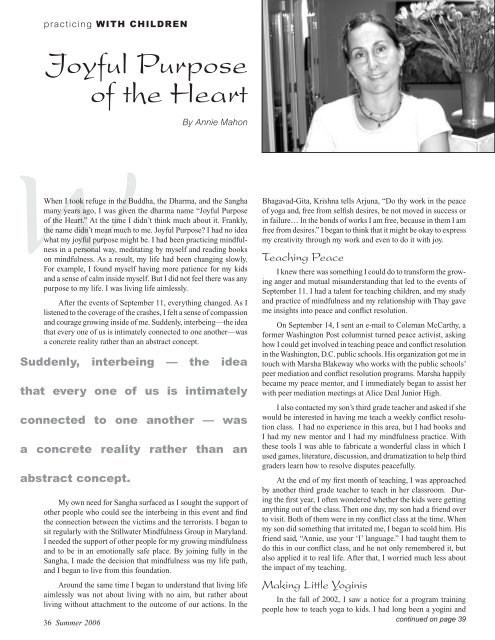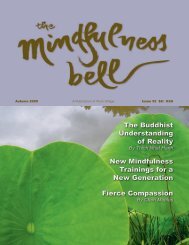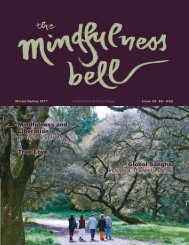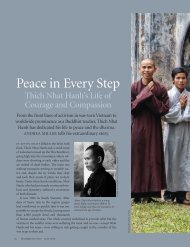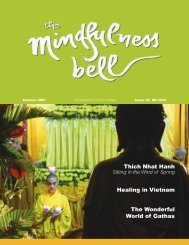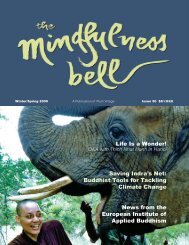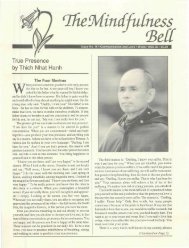Thich Nhat Hanh Jewish Roots The Better Way to Live Alone in the ...
Thich Nhat Hanh Jewish Roots The Better Way to Live Alone in the ...
Thich Nhat Hanh Jewish Roots The Better Way to Live Alone in the ...
- No tags were found...
Create successful ePaper yourself
Turn your PDF publications into a flip-book with our unique Google optimized e-Paper software.
practic<strong>in</strong>g WITH CHILDRENJoyful Purposeof <strong>the</strong> HeartBy Annie MahonWWhen I <strong>to</strong>ok refuge <strong>in</strong> <strong>the</strong> Buddha, <strong>the</strong> Dharma, and <strong>the</strong> Sanghamany years ago, I was given <strong>the</strong> dharma name “Joyful Purposeof <strong>the</strong> Heart.” At <strong>the</strong> time I didn’t th<strong>in</strong>k much about it. Frankly,<strong>the</strong> name didn’t mean much <strong>to</strong> me. Joyful Purpose? I had no ideawhat my joyful purpose might be. I had been practic<strong>in</strong>g m<strong>in</strong>dfulness<strong>in</strong> a personal way, meditat<strong>in</strong>g by myself and read<strong>in</strong>g bookson m<strong>in</strong>dfulness. As a result, my life had been chang<strong>in</strong>g slowly.For example, I found myself hav<strong>in</strong>g more patience for my kidsand a sense of calm <strong>in</strong>side myself. But I did not feel <strong>the</strong>re was anypurpose <strong>to</strong> my life. I was liv<strong>in</strong>g life aimlessly.After <strong>the</strong> events of September 11, everyth<strong>in</strong>g changed. As Ilistened <strong>to</strong> <strong>the</strong> coverage of <strong>the</strong> crashes, I felt a sense of compassionand courage grow<strong>in</strong>g <strong>in</strong>side of me. Suddenly, <strong>in</strong>terbe<strong>in</strong>g—<strong>the</strong> ideathat every one of us is <strong>in</strong>timately connected <strong>to</strong> one ano<strong>the</strong>r—wasa concrete reality ra<strong>the</strong>r than an abstract concept.Suddenly, <strong>in</strong>terbe<strong>in</strong>g — <strong>the</strong> ideathat every one of us is <strong>in</strong>timatelyconnected <strong>to</strong> one ano<strong>the</strong>r — wasa concrete reality ra<strong>the</strong>r than anabstract concept.My own need for Sangha surfaced as I sought <strong>the</strong> support ofo<strong>the</strong>r people who could see <strong>the</strong> <strong>in</strong>terbe<strong>in</strong>g <strong>in</strong> this event and f<strong>in</strong>d<strong>the</strong> connection between <strong>the</strong> victims and <strong>the</strong> terrorists. I began <strong>to</strong>sit regularly with <strong>the</strong> Stillwater M<strong>in</strong>dfulness Group <strong>in</strong> Maryland.I needed <strong>the</strong> support of o<strong>the</strong>r people for my grow<strong>in</strong>g m<strong>in</strong>dfulnessand <strong>to</strong> be <strong>in</strong> an emotionally safe place. By jo<strong>in</strong><strong>in</strong>g fully <strong>in</strong> <strong>the</strong>Sangha, I made <strong>the</strong> decision that m<strong>in</strong>dfulness was my life path,and I began <strong>to</strong> live from this foundation.Around <strong>the</strong> same time I began <strong>to</strong> understand that liv<strong>in</strong>g lifeaimlessly was not about liv<strong>in</strong>g with no aim, but ra<strong>the</strong>r aboutliv<strong>in</strong>g without attachment <strong>to</strong> <strong>the</strong> outcome of our actions. In <strong>the</strong>36 Summer 2006Bhagavad-Gita, Krishna tells Arjuna, “Do thy work <strong>in</strong> <strong>the</strong> peaceof yoga and, free from selfish desires, be not moved <strong>in</strong> success or<strong>in</strong> failure… In <strong>the</strong> bonds of works I am free, because <strong>in</strong> <strong>the</strong>m I amfree from desires.” I began <strong>to</strong> th<strong>in</strong>k that it might be okay <strong>to</strong> expressmy creativity through my work and even <strong>to</strong> do it with joy.Teach<strong>in</strong>g PeaceI knew <strong>the</strong>re was someth<strong>in</strong>g I could do <strong>to</strong> transform <strong>the</strong> grow<strong>in</strong>ganger and mutual misunderstand<strong>in</strong>g that led <strong>to</strong> <strong>the</strong> events ofSeptember 11. I had a talent for teach<strong>in</strong>g children, and my studyand practice of m<strong>in</strong>dfulness and my relationship with Thay gaveme <strong>in</strong>sights <strong>in</strong><strong>to</strong> peace and conflict resolution.On September 14, I sent an e-mail <strong>to</strong> Coleman McCarthy, aformer Wash<strong>in</strong>g<strong>to</strong>n Post columnist turned peace activist, ask<strong>in</strong>ghow I could get <strong>in</strong>volved <strong>in</strong> teach<strong>in</strong>g peace and conflict resolution<strong>in</strong> <strong>the</strong> Wash<strong>in</strong>g<strong>to</strong>n, D.C. public schools. His organization got me <strong>in</strong><strong>to</strong>uch with Marsha Blakeway who works with <strong>the</strong> public schools’peer mediation and conflict resolution programs. Marsha happilybecame my peace men<strong>to</strong>r, and I immediately began <strong>to</strong> assist herwith peer mediation meet<strong>in</strong>gs at Alice Deal Junior High.I also contacted my son’s third grade teacher and asked if shewould be <strong>in</strong>terested <strong>in</strong> hav<strong>in</strong>g me teach a weekly conflict resolutionclass. I had no experience <strong>in</strong> this area, but I had books andI had my new men<strong>to</strong>r and I had my m<strong>in</strong>dfulness practice. With<strong>the</strong>se <strong>to</strong>ols I was able <strong>to</strong> fabricate a wonderful class <strong>in</strong> which Iused games, literature, discussion, and dramatization <strong>to</strong> help thirdgraders learn how <strong>to</strong> resolve disputes peacefully.At <strong>the</strong> end of my first month of teach<strong>in</strong>g, I was approachedby ano<strong>the</strong>r third grade teacher <strong>to</strong> teach <strong>in</strong> her classroom. Dur<strong>in</strong>g<strong>the</strong> first year, I often wondered whe<strong>the</strong>r <strong>the</strong> kids were gett<strong>in</strong>ganyth<strong>in</strong>g out of <strong>the</strong> class. <strong>The</strong>n one day, my son had a friend over<strong>to</strong> visit. Both of <strong>the</strong>m were <strong>in</strong> my conflict class at <strong>the</strong> time. Whenmy son did someth<strong>in</strong>g that irritated me, I began <strong>to</strong> scold him. Hisfriend said, “Annie, use your ‘I’ language.” I had taught <strong>the</strong>m <strong>to</strong>do this <strong>in</strong> our conflict class, and he not only remembered it, butalso applied it <strong>to</strong> real life. After that, I worried much less about<strong>the</strong> impact of my teach<strong>in</strong>g.Mak<strong>in</strong>g Little Yog<strong>in</strong>isIn <strong>the</strong> fall of 2002, I saw a notice for a program tra<strong>in</strong><strong>in</strong>gpeople how <strong>to</strong> teach yoga <strong>to</strong> kids. I had long been a yog<strong>in</strong>i andcont<strong>in</strong>ued on page 39O


